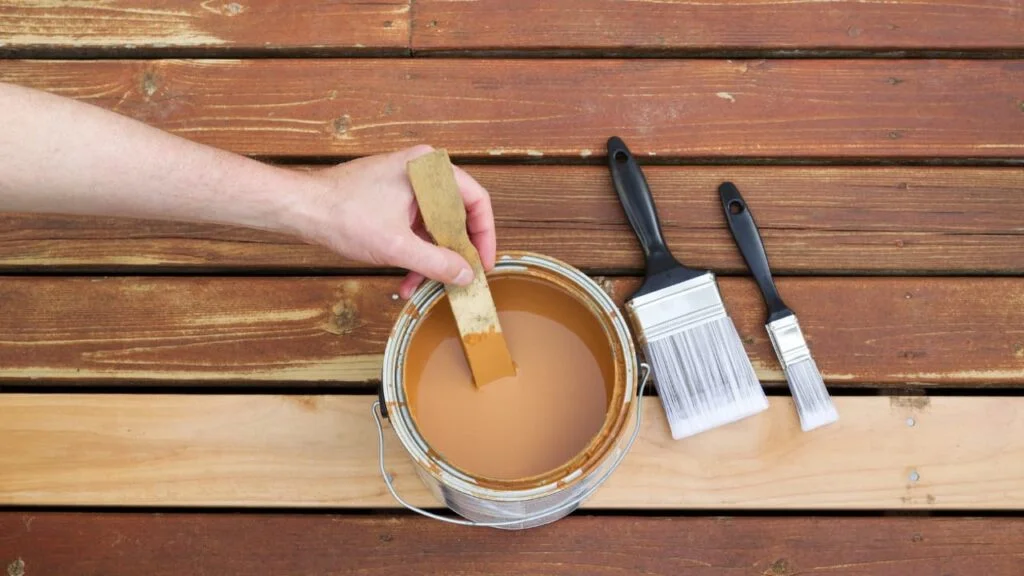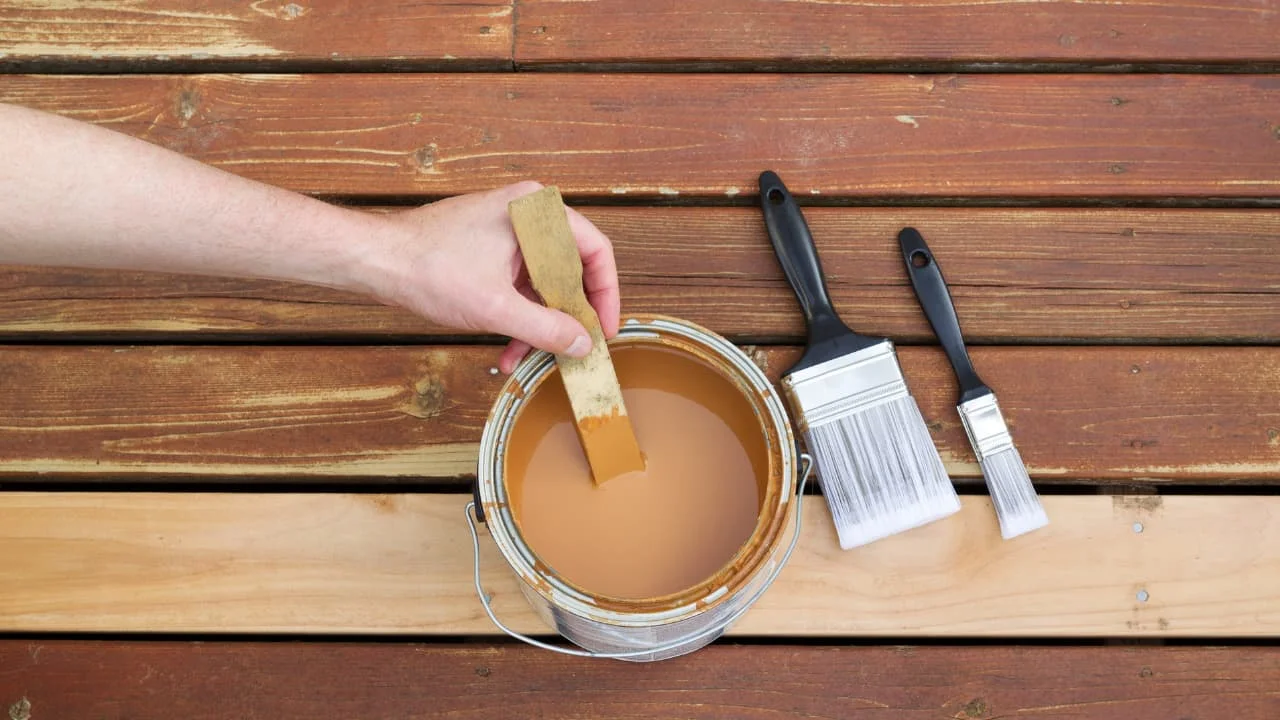Are you staring at a wood surface with an outdated or unappealing stain and wondering if it’s possible to paint over it? The answer is yes, but several factors come into play when deciding whether it makes sense to do so.
In this blog post, we will delve into the world of painting with paint over stained wood and surfaces, discussing different types of stains, preparation techniques, and the pros and cons of this approach, as well as exploring feasible alternatives.
Key Takeaways 💭
- Yes, you can paint over stain, but it’s important to consider factors such as the type of stain and surface, proper preparation techniques, and choosing the right type of paint.
- Painting over stain has benefits such as affordability and a fresh new look, but also drawbacks like adhesion issues and visibility of imperfections.
- Alternatives to painting over stain include staining over paint for a unique look or stripping the stain for better adhesion. The decision on whether to paint over stain should consider factors such as surface condition and age, desired outcome and budget, and seeking professional advice.
Table of Contents

Can You Paint Over Stain And When Does It Make Sense To Do So?
To determine whether it makes sense to paint over stain, you need to consider the type of stain and surface, properly prepare the surface for painting, and choose the right type of paint.
Understanding The Types Of Stain And Surfaces
To successfully paint over wood stains, it is important to comprehend the different types of stains available and the surfaces they are applied on. Wood stains typically fall into two categories: oil-based and water-based.
Oil-based stains penetrate deeper into the wood surface, providing a durable matte finish that enhances the natural beauty of wood grain patterns.
When dealing with various surfaces such as furniture pieces, cabinets, or trim work, one must consider factors like existing finishes and materials used in construction. For instance, pre-finished furniture items from thrift stores may have an unknown type of finish that could cause issues when painting over them; conversely, older homes commonly feature heavily varnished trims which may require additional preparation steps before applying any paint product.
Properly Preparing The Surface For Painting
Before painting over a stain, it’s essential to properly prepare the surface for optimal adhesion and durability of the paint. To begin with, a paint job, make sure the surface is clean and free from dust or dirt buildup that could affect paint application.
Additionally, you may need to remove any hardware or handles that could get in your way while painting. If working on cabinets or floors, use masking tape around adjacent surfaces to prevent accidental spills or smudging.
Choosing The Right Type Of Paint
Choosing the right type of paint is crucial when painting over stain. The type of paint you choose will depend on the surface and the desired outcome. For example, if you’re painting kitchen cabinets or floors that receive a lot of wear and tear, it’s important to select durable paint that can withstand heavy use.
In this case, acrylic or latex-based paints are ideal as they provide excellent adhesion and durability.
On the other hand, oil-based paints work well for outdoor surfaces like decks or fences because they are more resistant to weather conditions and UV rays.
Water-based stains also offer an option for those who want to maintain some level of wood grain visibility while covering up flaws in their stained wood furniture or thrift store finds.
Pros And Cons Of Painting Over Stain
Painting over stain can provide many benefits, such as cost savings and aesthetic appeal; however, it also has drawbacks including potential issues with adhesion and visibility of imperfections.
Benefits Of Painting Over Stain, Including Cost Savings And Aesthetic Appeal
Painting over stain can provide significant benefits, including cost savings and a fresh new look for the surface. Instead of having to completely strip and restain woodwork or furniture, painting over stain allows for a quick fix that is both affordable and attractive.
Additionally, painting over stain opens up a wide range of color options to match any decor scheme or personal preference. With the proper preparation, such as sanding and using a top primer paint, like latex or acrylic paint, adhesion issues can be avoided.
Whether it’s updating thrift store finds or giving cabinets, floors, trim work, or decks a facelift before selling your home as recommended by realtors, painting over stained surfaces is an excellent alternative to more costly refinishing projects.
Drawbacks Of Painting Over Stain, Including Potential Issues With Adhesion And Visibility Of Imperfections
While there are benefits to painting over stain, including cost savings and the ability to give a new look to an old piece of furniture or surface, there are also some drawbacks that should be considered.
One potential issue is adhesion- if the surface has not been properly prepared or if the paint used is not suitable for the type of stain being covered, then it may not adhere to chalk paint properly and could result in peeling or chipping.
For example, imagine you want to paint over a dark oil-based stain on your kitchen cabinets with acrylic paint. If you don’t sand and prime the surface after first coat, with a latex primer specifically designed for covering stains like this one, then your new coat of paint might not stick successfully.
Moreover, any dents or scratches caused by years of use will still show through despite applying fresh paint and coats of color on top.
Alternatives To Painting Over Stain
Staining over paint offers a unique look, while stripping the stain is more time-consuming but effective.
Staining Over Paint: A Potential Solution For A Unique Look
Staining over paint is an alternative to painting over stain, and offers a unique way to update the appearance of wood surfaces. This approach involves applying a thin layer of wood stain directly over painted surfaces, creating a subtle tint that complements the existing color.
However, staining over latex paint does require some preparation work to ensure proper adhesion. It’s important to clean and lightly sand the surface beforehand, and choose a compatible water-based stain for latex-painted surfaces or an oil-based stain for oil-painted surfaces.
Stripping The Stain: A More Time-consuming But Effective Option
Stripping the stain is a more time-consuming but effective option for those who prefer to completely remove the existing stain before painting. This process involves using chemical strippers or sanding down the wood to its natural state.
Although it takes longer, stripping the top coat of stain allows for better adhesion of paint and eliminates any imperfections that may have been present in the previous finish.
It’s important to note that this option requires proper protective gear and should be done in a well-ventilated area.
An example of when stripping might be a good choice would be on an old thrift store find with multiple layers of different colored stains. By removing all layers, you’ll have a blank canvas that makes it easy to paint whatever color suits your fancy without worrying about mixing existing colors together and ruining your final product.
Making The Decision: Factors To Consider
Consider the surface condition and age, desired outcome, and budget, as well as professional advice and experience when making a decision on whether to paint over stain.
Surface Condition And Age
The condition and age of the surface that you plan to paint over is an important consideration before proceeding with painting over stain. For older or heavily weathered surfaces, it may be difficult to achieve proper adhesion with the new coat of paint.
In some cases, sanding down the surface might help create a smoother canvas for painting.
If you’re working on newer surfaces that are in good condition, you may not need to worry as much about adhesion issues. You should still clean and prepare the surface properly before painting over stain.
Another factor to keep in mind is whether there are any imperfections in the wood grain or finish that could be accentuated by adding more layers of color with paint.
In these cases, it may make sense to explore alternative options like staining over paint instead of starting from scratch.
Desired Outcome And Budget
Before deciding to paint over stain, it’s important to consider your desired outcome and budget.
Keep in mind that painting over stain may not be the best option for every scenario – in some cases, stripping the stain or staining over existing paint may yield better results.
Professional Advice And Experience
It’s always a good idea to seek professional advice when considering whether or not to paint over stain. Experienced contractors, carpenters, and other professionals can offer valuable insight into the best course of action based on their knowledge and expertise in dealing with stained furniture and surfaces.
Realtors are also a great resource if you’re looking to sell your property after refinishing its wood features. They usually know what kind of finishes are more appealing among buyers in your region or demographic group, helping you make an informed decision about refinishing stained wood cabinets or floors.
Conclusion: Weighing The Options And Determining The Best Course Of Action.
In conclusion, deciding whether to paint over stain requires careful consideration of various factors. While painting over stain can be a cost-effective way to update an old piece of furniture or revitalize a tired deck, it’s important to take into account the type of surface and stain, as well as its condition and age.
Proper preparation, including sanding or stripping, is crucial for ensuring good adhesion and optimal paint coverage.
Ultimately, while there are pros and cons to painting over stain, alternatives such as staining over paint or completely removing the stain may also be worth exploring depending on the desired outcome and budget constraints.
For those unsure about their DIY skills or seeking professional advice, consulting with experts in wood finishing and restoration can provide valuable guidance.
FAQs:
Can you paint over stain without removing it first?
Yes, but it is important to use a primer specifically designed for painting over stain and to ensure the surface is properly cleaned and sanded beforehand to guarantee the adhesion of bonding primer to the new paint layer.
Does painting over stain make sense in terms of durability?
While just painting over stained wood surfaces may be possible, it may not always be the most durable or long-lasting option available. If the underlying wood or other material has become damaged from water exposure or age-related wear-and-tear, using a proper wood filler or replacing components entirely may provide better results.
What types of stains are best suited for being painted over?
Certain types of stains such as oil-based stains can cause issues with later paint adhesion and fading if not addressed properly during preparation steps. Water-based stains can often be more easily painted over since they allow for more effective penetration by primers and paints.
Can I mix different paint colors when painting on top of stained surfaces?
Mixing colors while painting stained surfaces can lead to unexpected results if certain pigments interact poorly with each other or don’t adhere correctly to previously treated areas. It’s generally recommended that multiple coats be applied instead as needed rather than attempting color mixing mid-project unless thoroughly prepared ahead of time by testing small sections of stained surface first.

